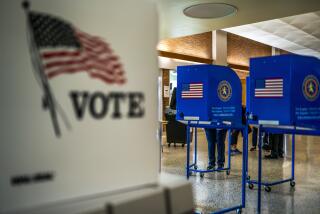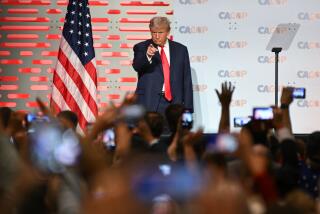Opinion: Forget the Oscars, the real diversity problem is #IowaCaucusSoWhite
As I write this, the good people of Iowa are preparing for the start of an evening of vigorous debate and voting. What the Democrats of this state decide tonight may well determine the course of the presidential primaries in other states and the November election.
And there’s something very wrong about that.
No disrespect to Iowans. God bless them for being willing to put up with a media circus every four years followed by an extremely involved process of choosing their favorite presidential candidate.
I am not sure Democratic voters in larger states such as my own would ever consent to a process that required them to venture into the cold February night to spend hours debating with their neighbors about the relative flaws and virtues of the various presidential candidates. Not unless it involved wine.
For this investment of time, Iowans deserve a place of prominence in the primary pack. But should it be the first state to weigh in — for now and always — as it has for almost 50 years, thus giving it an outsize influence on the presidential race?
I don’t think so. Nor do a growing number of people who are questioning whether vaunted first-in-the-nation status should be granted indefinitely to a tiny state that is about 85% white and non-Latino, and that has no large urban area to speak of. That demographic might have once reflected the Democratic Party (and might reflect the Republican Party within a few election cycles if it can’t figure out how to stop scaring away Latinos and black Americans), but it certainly doesn’t in 2020. According to the U.S. Census, the demographic breakdown of Americans is 60% non-Latino white, 18% Latino, 13% black and 6% Asian.
That’s bad enough, but the contest in the small white Midwest state is followed up by a primary in the even smaller and whiter northeastern state of New Hampshire (90% non-Latino white). Maybe that’s OK with Republicans, who seem to have written off non-white voters, but it shouldn’t sit well with Democrats who purport be a party of equality and diversity.
Thanks to former HUD Secretary Julian Castro for starting the conversation about the sequence of primaries and its implications for non-white candidates before he dropped out of the race in December because of low polling in places such as Iowa. Castro pointed out the hypocrisy of his party calling out Republicans’ efforts to disenfranchise people of color and then holding its first two primary contests in overwhelmingly white states. “It’s time that our presidential nominating process reflects our nation’s and our party’s diversity,” he said.
Former New York City Mayor Michael R. Bloomberg too is critical of the party’s primary schedule, though not just because of the diversity question. He thinks it is kind of nuts for candidates to focus so much time and money on two states that aren’t going to be pivotal in the November election. “Right now,” Bloomberg warned in an op-ed last month, “we are in danger of repeating 2016 in large part because, as Democrats focus on Iowa and New Hampshire, Trump is operating at full-speed in the battleground states, with field staff and targeted television and digital advertisements.”
In 2008 the Democratic Party moved up the Nevada and South Carolina primaries to address the growing concern with the disproportionate power concentrated in the hands of two super white states. Fewer than half of Nevadans are non-Latino white, while about 30% are Latino and 10% are black. South Carolina doesn’t have many Latinos, but about 27% of the population is black.
But it didn’t really solve anything. Rather than displacing Iowa or New Hampshire as the front-runners, those states were stuck in third and fourth place, left to hold their contests at the end of the month and just before Super Tuesday. The symbolism of that placement ought to make the party leaders uncomfortable.
By the way, I am not suggesting California be given priority status. If Iowa doesn’t reflect the diversity of the country, California over-reflects it. Besides, I don’t think it’s feasible to expect even well-funded candidates to be capable of campaigning in any meaningful way in a state that is 800 miles long with 40 million people living in 12 separate media markets.
One obvious quick fix is to shift the positions of the first four primary states so that Nevada and South Carolina gets one of the top two spots. That would at least be a start, but perhaps the primary process itself needs a more thorough examination. Why is it staggered this way? Why can’t we have primaries in every state on the same day? Why not have top two primaries like California’s?
Obviously, this isn’t going to get answered this year. But it’s something that should be addressed long before 2024.
More to Read
A cure for the common opinion
Get thought-provoking perspectives with our weekly newsletter.
You may occasionally receive promotional content from the Los Angeles Times.











